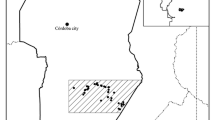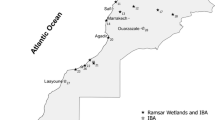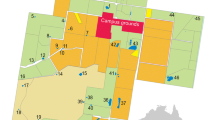Abstract
Species occurrence and community structure are strongly influenced by multiple factors like habitat selection, species movement capabilities, competition, or conspecific and heterospecific attractions. More specifically, in waterbird communities, previous studies have identified the importance of environmental and structural characteristics of wetlands for their occupation and use. However, the effect of the surrounding landscape configuration remains unknown. In this article, we use a large network of artificial irrigation ponds to evaluate the importance of pond features in comparison to the effect of landscape and spatial configuration on the community at three different spatial scales. Our results show that landscape configuration has relatively little influence on structure of the waterbird community. Pond features were by far the most important variables to describe waterbird abundance and richness. At the species level, we detected differences in habitat preferences relating to species-specific ecological requirements. Our results highlight the importance of using a multiscale approach to understand and predict richness and abundance in waterbird communities. Our findings emphasize the need to maintain high-quality ponds to enhance their suitability for use as breeding and foraging sites.



Similar content being viewed by others
References
Abellán P, Sánchez-Fernández D, Millán A, Botella F, Sánchez-Zapata JA, Giménez A (2006) Irrigation ponds as macroinvertebrates habitat in a semi-arid agricultural landscape (SE Spain). J Arid Environ 67:255–269
Alexander K, Sebastián-González E, Sánchez-Zapata JA, Botella F (2011) Identifying irrigation pond preferences for black-winged stilts Himantopus himantopus using occupancy data. Ardeola 58(1):175–182
Anderson MJ, Cribble NA (1998) Partitioning the variation among spatial, temporal and environmental components in a multivariate data set. Aust J Ecol 23(2):158–167. doi:10.1111/j.1442-9993.1998.tb00713.x
Benton TG, Vickery JA, Wilson JD (2003) Farmland biodiversity: is habitat heterogeneity the key? Trends Ecol Evol 18:182–188
Blondel J, Aronson J (1999) Biology and wildlife of the Mediterranean region. Oxford University Press, Oxford
Brady MJ, Mcalpine CA, Miller CJ, Possingham HP, Baxter GS (2011) Mammal responses to matrix development intensity. Aust Ecol 36:35–45. doi:10.1111/j.1442-9993.2010.02110.x
Burnham KP, Anderson DR (2002) Model selection and multimodal inference: a practical information theoretic approach. Springer-Verlag, New York
Burton NHK (2007) Landscape approaches to studying the effects of disturbance on waterbirds. Ibis 144:95–105
Ceréghino R, Biggs J, Oertli B, Declerck S (2008) The ecology of European ponds: defining the characteristics of a neglected freshwater habitat. Hydrobiologia 597:1–6
Chamberlain DE, Fuller RJ, Bunce RGH, Duckworth JC, Shrubb M (2000) Changes in the abundance of farmland birds in relation to changes in agricultural practices in England and Wales. J Appl Ecol 37:771–788
Chan SF, Severinghaus LL, Lee CK (2007) The effect of rice field fragmentation on wintering waterbirds at the landscape level. J Ornithol 148(2):333–342
Cody ML (1985) Habitat selection in birds. Academic Press, New York
Cunningham M-A, Johnson DH (2006) Proximate and landscape factors influence grassland bird distributions. Ecol Appl 16:1062–1075
Cushman SA, McGarigal K (2002) Hierarchical, multi-scale decomposition of species-environment relationships. Landsc Ecol 17:637–646
Davies BR, Thoms M, Meador M (1992) An assessment of the ecological impacts of inter-basin water transfers, and their threats to river basin integrity and conservation. Aquat Conserv Mar Freshw Ecosyst 2:325–349
De Meester L, Declerck S, Stocks R, Louette G, Van de Meutter F, De Brie T, Michels E, Brendonck L (2005) Ponds and pools as model systems in conservation biology, ecology and evolutionary biology. Aquat Conserv Mar Freshw Ecosyst 15:715–725
Del Hoyo J, Elliot A, Sargatal J (1992) Handbook of the birds of the world, vol 1: Ostrich to Ducks. Lynx Ediciones, Barcelona
Donald PF, Green RE, Heath MF (2001) Agricultural intensification and the collapse of Europe’s farmland bird populations. Proc R Soc Lond Ser B 268:25–29
Ekroos J, Kuussaari M (2012) Landscape context affects the relationship between local and landscape species richness of butterflies in semi-natural habitats. Ecography 35(3):232–238
Elphick CS, Oring LW (2003) Conservation implications of flooding rice fields on winter waterbird communities. Agric Ecosyst Environ 94:17–29. doi:10.1016/S0167-8809(02)00022-1
Estades C, Temple SA (1999) Deciduous forest birds communities in a fragmented landscape dominated by exotic pine plantations. Ecol Appl 9:573–585
EEA European Environment Agency (2011) CORINE 2006 seamless vector dataset. Version 15. Retrieved June 3, 2011 fromhttp://www.eea.europa.eu/data-and-maps/data/clc-2006-vector-data-version-2
Fahrig L, Baudry J, Brotons L, Burel FG, Crist TO, Fuller RJ, Sirami C, Siriwardena GM, Martin JL (2011) Functional landscape heterogeneity and animal biodiversity in agricultural landscapes. Ecol Lett 14:101–112
Fleishman E, Ray C, Sjögren-Gulve P, Boggs CL, Murphy DD (2002) Assessing the roles of patch quality, area and isolation in predicting metapopulation dynamics. Conserv Biol 16:706–716
Frey SJ, Strong AM, McFarland KP (2012) The relative contribution of local habitat and landscape context to metapopulation process: a dynamic occupancy modelling approach. Ecography 35:581–589
Froneman A, Mangnall MJ, Little RM, Crowe TM (2001) Waterbird assemblages and associated habitat characteristics of farm ponds in the Western Cape, South Africa. Biodivers Conserv 10:251–270
Graham MH (2003) Confronting multicollinearity in ecological multiple regression. Ecology 84:2809–2815
Green RE, Cornell SJ, Scharlemann JPW, Balmford A (2005) Farming and the fate of wild nature. Science 307:550–555
Guadagnin DL, Maltchik L (2007) Habitat and landscape factors associated with neotropical waterbird occurrence and richness in wetland fragments. Biodivers Conserv 16:1231–1244
Haig SM, Mehlman DW, Oring LW (1998) Avian movements and wetland connectivity in landscape conservation. Conserv Biol 12:749–758
Hamer AJ, Parris KM (2011) Local and landscape determinants of amphibian communities in urban ponds. Ecol Appl 21(2):378–390
Hanowski JM, Niemi GJ, Christian DC (1997) Influence of within plantation heterogeneity and surrounding landscape composition on avian communities in hybrid poplar plantations. Conserv Biol 11(4):936–944
Hazell D, Cunningham R, Lindenmayer D, Mackey B, Osborne W (2001) Use of dams as frog habitat in an Australian agricultural landscape: factors affecting species richness and distribution. Biol Conserv 102:155–169
Hollis GE (1990) Environmental impacts of development on wetlands in arid and semi-arid lands. Hydrol Sci J 35(4):411–428
Julian JT, Craig DS, Young JA (2006) The use of artificial impoundments by two amphibian species in the Delaware Water Gap National Recreation Area. Northeast Nat 13(4):459–468
King S, Elphick CS, Guadagnin D, Taft O, Amano T (2010) Effects of landscape features on waterbird use of rice fields. Waterbirds 33(1):151–159
Knutson MG, Sauer JR, Olsen DA, Mossman MJ, Hemesath LM, Lannoo MJ (1999) Effects of landscape composition and wetland fragmentation on frog and toad abundance and species richness in Iowa and Wisconsin, USA. Conserv Biol 13(6):1437–1446
Knutson MG, Richardson WB, Reineke DM, Gray BR, Parmelee JR, Weick SE (2004) Agricultural ponds support amphibian populations. Ecol Appl 14(3):669–684. doi:10.1890/02-5305
Legendre P (1993) Spatial autocorrelation: trouble or new paradigm? Ecology 74:1659–1673
Legendre P, Legendre L (1998) Numerical ecology, 2nd edn. Elsevier, Amsterdam
Levin SA (1992) The problem of pattern and scale in ecology. Ecology 73:1943–1976
Lindenmayer D, Hobbs RJ, Montague-Drake R, Alexandra J, Bennett A, Burgman M, Cale P, Calhoun A, Cramer V, Cullen P, Driscoll D, Fahrig L, Fischer J, Franklin J, Haila Y, Hunter M, Gibbons P, Lake S, Luck G, MacGregor C, McIntyre S, Nally RM, Manning A, Miller J, Mooney H, Noss R, Possingham H, Saunders D, Schmiegelow F, Scott M, Simberloff D, Sisk T, Tabor G, Walker B, Wiens J, Woinarski J, Zavaleta E (2008) A checklist for ecological management of landscapes for conservation. Ecol Lett 11:78–91
Ma Z, Li B, Zhao B, Ping K, Tang S, Chen J (2004) Are artificial wetlands good alternatives to natural wetlands for waterbirds?—a case study on Chongming Island, China. Biodivers Conserv 13:333–350. doi:10.1023/B:BIOC.0000006502.96131.59
Mazerolle MJ, Villard MA (1999) Patch characteristics and landscape context as predictors of species presence and abundance: a review. Ecoscience 6:117–124
Mazerolle MJ, Desrochers A, Rochefort L (2005) Landscape characteristics influence pond occupancy by frogs after accounting for detectability. Ecol Appl 15:824–834
McCulloch CE, Searle SR (2000) Generalized linear and mixed models. Wiley-Interscience, New York
Moilanen A, Hanski I (1998) Metapopulation dynamics: effects of habitat quality and landscape structure. Ecology 79:2503–2515
Montes C (1991) Estudio de las zonas húmedas de la España peninsular. Inventario y tipificación. MOPTMA, Madrid
Múrias T, Cabral JA, Lopes R, Marques JC, Goss-Custard J (2002) Use of traditional salines by waders in the Mondego estuary (Portugal): a conservation perspective. Ardeola 49(2):223–240
Öberg S, Ekbon B, Bommarco R (2007) Influence of habitat type and surrounding landscape on spider diversity in Swedish agroecosystems. Agric Ecosyst Environ 122(2):211–219
Paracuellos M, Tellería JL (2004) Factors affecting the distribution of a waterbird community: the role of habitat configuration and bird abundance. Waterbirds 27(4):446–453
Pasinelli G, Schiegg K (2006) Fragmentation within and between wetland reserves: the importance of spatial scales for nest predation in Reed Buntings. Ecography 29:721–732
Pita R, Mira A, Moreira F, Morgado R, Beja P (2009) Influence of landscape characteristics on carnivore diversity and abundance in Mediterranean farmland. Agric Ecosyst Environ 132(1–2):57–65
Prugh LR, Hodges KE, Sinclair ARE, Brashares JS (2008) Effect of habitat area and isolation on fragmented animal populations. Proc Natl Acad Sci U S A 105:20770–20775
R Development Core Team (2008) R: A language and environment for statistical computing. R Foundation for Statistical Computing, Vienna, Austria
Ranganathan J, Krishnaswamy J, Anand MO (2010) Landscape-level effects on avifauna within tropical agriculture in the Western Ghats: insights for management and conservation. Biol Conserv 143(12):2909–2917
Ribeiro DB, Batista R, Prado PI, Brown KS, Freitas AVL (2012) The importance of small scales to the fruit-feeding butterfly assemblages in a fragmented landscape. Biodivers Conserv 21(3):811–827. doi:10.1007/s10531-011-0222-x
Sánchez-Zapata JA, Anadón JD, Carrete M, Giménez A, Navarro J, Villacorta C, Botella F (2005) Breeding waterbirds in relation to artificial pond attributes: implications for the design of irrigation facilities. Biodivers Conserv 14:1627–1639
Santoul F, Figuerola J, Green A (2004) Carrying capacity of gravel pits for the avian community in the Garonne river floodplain (south-west, France). Biodivers Conserv 13(6):1231–1243
Schoener TW (1968) Sizes of feeding territories among birds. Ecology 49:123–141. doi:10.2307/1933567
Sebastián-González E, Green JA (2014) Habitat use by waterbirds in relation to pond size, water depth and isolation: lessons from a restoration in Southern Spain. Restor Ecol 22:311–318
Sebastián-González E, Sánchez-Zapata JA, Botella F (2010a) Agricultural ponds as alternative habitat for waterbirds: spatial and temporal patterns of abundance and management strategies. Eur J Wildl Res 56:11–20
Sebastián-González E, Sánchez-Zapata JA, Botella F, Ovsakainen O (2010b) Testing the heterospecific attraction hypothesis with time-series data on species co-occurrence. Proc R Soc B 277:2983–2990
Sebastián-González E, Botella F, Sempere R, Sánchez-Zapata JA (2010c) An empirical demonstration of the ideal free distribution: little grebes Tachybaptus ruficollis breeding in intensive agricultural landscapes. Ibis 152:643–650
Shannon CE (1948) A mathematical theory of communication. Bell Syst Tech J 27:379–423
Simon JA, Snodgrass JW, Casey RE, Sparling DW (2009) Spatial correlates of amphibian use of constructed wetlands in an urban landscape. Landscape Ecol 24(3):361–373
Sisk TD, Haddad NM, Ehrlich PR (1997) Bird assemblages in patchy woodlands: modeling the effects of edge and matrix habitats. Ecol Appl 7(4):1170–1180
Steen VA, Powell AN (2012) Wetland selection by breeding and foraging black terns in the Prairie Pothole region of the United States. Condor 114:155–165
Swift MJ, Izac AMN, van Noordwijk M (2004) Biodiversity and ecosystem services in agricultural landscapes—are we asking the right questions? Agric Ecosyst Environ 104:113–134
Thornton DH, Branch LC, Sunquist ME (2011) The influence of landscape, patch, and within-patch factors on species presence and abundance: a review of focal patch studies. Landsc Ecol 26:7–18
Tscharntke T, Klein AM, Kruess A, Steffan-Dewenter I, Thies C (2005) Landscape perspectives on agricultural intensification and biodiversity: ecosystem service management. Ecol Lett 8:857–874
Turner MG (2005) Landscape ecology: what is the state of the science? Ann Rev Ecol Evol Syst 36:319–344
Vergara PM, Armesto JJ (2009) Responses of Chilean forest birds to anthropogenic habitat fragmentation across spatial scales. Landsc Ecol 24:25–38
Weller MW (1999) Wetland birds: habitat resources and conservation implications. Cambridge University Press, Cambridge
Wiens JA (2002) Central concepts and issues of landscape ecology. In: Gutzwiller KJ (ed) Applying landscape ecology in biological conservation. Spinger-Verlag, New York, pp 3–21
Wiens JA, Stenseth NC, Van Home B, Ims RA (1993) Ecological mechanisms and landscape ecology. Oikos 66:369–380
Acknowledgments
This study was funded by a VOLCAM project. We thank the Taray Servicios Ambientales association and all the volunteers for organizing and performing the surveys. E S-G and K.A. benefited from a FPU grant from the Spanish Ministry of Education. E S-G is currently supported by the 2013/02819-7 São Paulo Research Foundation-FAPESP grant. This work has been partially supported by the Generalitat Valenciana through the R&D project CTIDIB/2002/142 and by the Conselleria de Territori i Habitatge.
Author information
Authors and Affiliations
Corresponding author
Additional information
Communicated by C. Gortázar
Rights and permissions
About this article
Cite this article
Pérez-García, J.M., Sebastián-González, E., Alexander, K.L. et al. Effect of landscape configuration and habitat quality on the community structure of waterbirds using a man-made habitat. Eur J Wildl Res 60, 875–883 (2014). https://doi.org/10.1007/s10344-014-0854-8
Received:
Revised:
Accepted:
Published:
Issue Date:
DOI: https://doi.org/10.1007/s10344-014-0854-8




